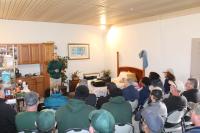
By Jay Jones
April is National Pest Management Awareness Month, which brings industry and regulators together to highlight the vital role pest management plays in protecting public health, food, and property from pest threats. In Georgia, it is also an opportunity to shine a light on what has made the industry successful.
In a study published by the Entomological Society of America this year, researchers found that Georgia’s professional pest management industry is one of the most robust industry sectors in the state, with revenue and employment growing 117 percent from 1997 to 2021. The study also found that Georgia’s pest management industry contributed between $1.7 billion and $2 billion and over 13,000 jobs to the state’s economy.
The study’s authors, University of Georgia faculty members Jacob Winkles, Benjamin Campbell, and Brian Forschler, used data from the U.S. Census, the U.S. Bureau of Labor Statistics, the Georgia Department of Agriculture Structural Pest Division, and anonymous surveys from business owners and employees.
Derrick Lastinger, GDA Structural Pest Division director, said those research findings are unsurprising when considering how much of an impact pests can have on Georgia’s economy.
“We live in the South, and we have a lot of bugs,” Lastinger said. “The importance of the industry to Georgia is much broader than controlling pests in the home. It plays a vital role in protecting our food supply and public health. Think about all of the food and goods coming through Port of Savannah and public health.”
Lastinger added that pest management is a very technical field that requires a lot of training. The GDA Structural Pest Division licenses 1,200 establishments and 12,000 individuals annually. All require an initial license certification and continuing education annually. “That’s to ensure they have the minimum knowledge to apply pesticides efficiently and safely, along with other control measures, and to maintain that knowledge,” Lastinger said.
The Georgia Structural Pest Control Commission is the industry’s oversight board, created by the 1955 Georgia Structural Pest Control Act. The commission members are appointed by the Georgia agricultural commissioner and are made up of industry representatives, consumers, researchers, and government officials. They advise the agriculture commissioner on regulation enforcement and ensure that companies and individuals are certified.
The Georgia Pest Control Association is the industry trade organization in the state. GPCA President Greg Holley said the state’s success in pest management is based on the partnership between pest management companies, state regulators, and academic researchers.
“The success is partly due because the commission puts all of these folks together in the same room in a commission meeting,” Holley said. “What is unique about Georgia is that when you go to the other states, the hand doesn’t know what the foot is doing. There’s no communication between those groups. Here, we have really good communication between those groups.”
Holley explained that open communications among the parties promote trust among everyone. He credited former Georgia Agriculture Commissioner Gary Black for setting that tone. “Regulation used to be done with a big stick, but when Commissioner Black came in, he changed that not just for regulation but across the board,” Holley said.
“Is it done with a big stick? Yeah, when it needs to be,” Holley said. “But as far as the inspectors in the field being empowered to educate companies, the ability to self-report, which was never there before, has since been done so effectively that it continues to be done even with a new commissioner.”
Lastinger reminds consumers of the importance of working with a licensed pest management professional if they have a pest issue. He said pest management professionals are highly trained to properly identify pests, which is always the first step in effective pest management.
Lastinger added that once the pest is identified, pest management professionals can access a wide range of control measures, such as specific insecticide baits or attractants. Some control measures require specialized application equipment to apply pesticides safely, and others require specialized training to use devices that provide control without pesticides.
Along with certification and continuing education of pest management professionals, the GDA Structural Pest Division responds to complaints related to pest management and the use of pesticides. The division also ensures consumer protection by conducting over 1,200 routine compliance monitoring inspections each year. To learn more about the Structural Pest Division, visit the website https://agr.georgia.gov/structural-pest-control.
Authored by Jay Jones, this article appeared in the April 17, 2024 edition of the Georgia Market Bulletin and Consumers Market Bulletin.


